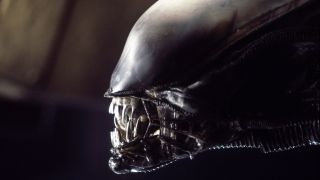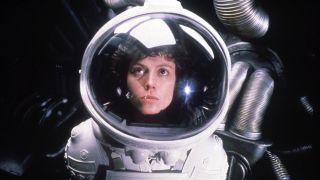By all rights, Alien should not have turned out nearly as well as it did. Greenlit in the wake of Star Wars, when every studio executive in Hollywood was desperately searching for sci-fi scripts, it was a derivative idea which owed its inspirations to schlocky low-budget B-movies with titles like Planet of the Vampires and Night of the Blood Beast. It was originated by two largely unproven screenwriters, Dan O’Bannon and Ronald Shusett, with a first draft titled Star Beast.
But under the guidance of producers Walter Hill and David Giler, with direction from a visionary filmmaker and some other incredibly fortuitous developments, Alien became a classic. All involved delivered superb contributions which made Alien not only a great movie in its own right, but one of the most influential movies in its genre.
Charting a classic

It’s tough to work out where to start with Alien’s brilliance, but its cast may be the right place. For a movie that is, in essence, a slasher in space – or Jaws in space – Alien pulled together a superb ensemble of performers to play the doomed Nostromo crew. John Hurt as the alien’s first victim Kane had previously appeared in productions as diverse as A Man for all Seasons and Midnight Express. Villainous science officer (and undercover android) Ash was played by reputable Shakespearean actor Ian Holm. Yaphet Kotto, playing Parker, was much in demand after portraying the villainous Dr Kananga in Roger Moore’s James Bond debut Live and let Die. Harry Dean Stanton was a character actor of note. Veronica Cartwright, as Lambert, had won an Emmy at the age of just 14. The least known of the cast, a newcomer called Sigourney Weaver, would become the most famous of them all. Before casting Weaver in the role of survivor Ellen Ripley, Alien’s producers had considered Meryl Streep for the role.

This feature first appeared in SFX. For more excellent content like this, be sure to subscribe to SFX magazine to get it delivered to your doorstep every month.
The cast lifted the source material far beyond its B-movie roots, in which the crew (all with different names) are nondescript male characters. They make the audience care about the victims of the alien in a way that can’t be said for many movies in the genre. It very nearly didn’t happen. "I remember getting the offer and reading the material," says Tom Skerritt, who played the Nostromo’s captain Dallas. "I asked for more background, and they said they had a budget of $2 million and no director. I read it and, well, it’s not really an actor’s script. At the time, I was being spoiled by having a lot of good roles coming along. My work up until that point involved directors like Robert Altman and Hal Ashby. It didn’t come off the page."
Skerritt turned the script down. However, he revisited it shortly after when Ridley Scott became attached as director. Scott – in his late thirties at the time – was still an unproven commodity in Hollywood, but he had shown himself as a filmmaker to watch through his movie debut, 1976’s The Duellists. "I remembered Ridley’s name because I was so impressed by the work," Skerritt tells us. Scott was a tremendous visualist, his skills honed by his previous successful career as a high-profile commercials director for everyone from Levi-Strauss Jeans to Hovis bread. Skerritt was awed by his mastery of every aspect of the filmmaking process. "Watching him work was amazing," he recalls. "He impressed me the way that it must have been for other actors watching Orson Welles when he was doing Citizen Kane." For Scott, Alien became the launchpad for a Hollywood career that has lasted ever since.
A beaten-up world

Working with some truly talented production designers and art directors, Scott’s vision for the world of Alien (and particularly the Nostromo spaceship) was for a roughhouse, lived-in science fiction universe wholly at odds with the pristine futurism of a movie like Stanley Kubrick’s masterpiece, 2001: A Space Odyssey. His concept was partially inspired after spotting graffiti in the toilet of a beaten-up 747 airplane during one of his many London-to-US flights. It was a blend of cutting edge technology and mundane, grubby reality. "I applied all this thinking, except having jumped ahead, say, a hundred years," he told author Tom Shone for the book Blockbuster.
But Scott was not a great director of actors at this stage in his career. Skerritt recalled how the first rehearsal, in Scott’s London office, set the tone. "We started doing a little bit of dialogue, and then he would interrupt to describe his visuals," he said. "It was fascinating but, in the half hour we were doing this, we only got a couple of lines in. He was so caught up in the vision of it." The rehearsal was interrupted when an assistant director came in to speak to Scott about a technical issue.
The director apologised and left the room. Skerritt remembered: "I immediately looked around at everybody and said, ‘I guess this makes me the captain of the ship. We might as well all know that we’re in this together.’" Scott, it turned out, didn’t become more hands on with his actors when the shoot started. The only time Skerritt recalls him commenting was after they had shot the breakfast scene, prior to the Nostromo landing on the planetoid LV-426. Scott’s comment after the scene? "Interesting." Skerritt remembers: "That was about the only thing I remember him saying to us."
True terror

Alien is, at its heart, a monster movie – and a movie like this is only as good as its monster. Prefiguring John Carpenter’s The Thing, the xenomorph in Alien constantly shifts forms. It begins as the facehugger, which impregnates Kane, only to violently emerge as the notorious chestburster ("When it happened, it scared the hell out of me," Skerritt recalls of that scene). Finally it grows to the fully grown xenomorph, although even then it is shown in such tiny snatches that its form remains a mystery until the final moments of the movie.
Keeping the alien hidden in this way was, according to Skerritt, inspired by a similar approach director Tobe Hooper had taken with Leatherface, the antagonist in his 1974 film The Texas Chainsaw Massacre. Ridley Scott had seen the movie and been greatly impressed by it. "That’s what he thought would work best with the creature," Skerritt explains. "Your own mind is much more frightening than what you might see. That’s how you get your audience. Less is more."

Come find out where Alien ranks on our best Sci-fi movies ever list and be sure to argue with us in the comments after
The alien’s strange, but iconic appearance – along with those of the chestburster, facehugger, alien ship and doomed "space jockey" – came courtesy of the late Swiss artist HR Giger. Giger’s designs for the creature recall a twisted blend of insect and serpent, with nods to the feverish imaginations of HP Lovecraft and Francis Bacon. Along with the vaginal imagery of the gaping doors of the derelict alien ship and alien egg, and the not-so-subtle fears of male childbirth, the phallic head of the alien gives the movie a weirdly sexual Freudian horror vibe which could keep shrinks in business for years.
As terrifying as the xenomorph was, though, it also led to one of Skerritt’s favourite memories of the shoot. "[It was a] lunch break where the 7’1" gentleman who was wearing the alien outfit had his head off, and was talking politics or economics with the 5’ tall wardrobe mistress," he laughs. "He was wearing bright blue Adidas tennis shoes. His tail was being carried by one of the wardrobe assistants. I’m so sorry I didn’t have a camera."
Alien bursts forth

Alien was shot at Shepperton Studios, just outside London. Its original budget of $4.5 million eventually expanded to $9 million, the same cost as the first Star Wars. It was filmed over 16 weeks, with an additional several months of post production. It was released on 25 May 1979. This was, by design, exactly two years to the day after Star Wars. Despite facing tough competition at the box office from films including Rocky II, Moonraker, and reissues of Jaws and Star Wars, Alien proved a success. It raked in $40 million in the US and $100 million worldwide.
It proved a hit with critics as well, even if the initial movie reviews tended to play up the film as a fun scary romp instead of a haunting sci-fi classic. "Unpretentious, skilfully sustained, technically dazzling," screamed John Hartl of the Seattle Times. "Seeing Alien is like stepping onto a funhouse ride," proclaimed Michael Janusonis of the Providence Journal-Bulletin. "Terrific fun for everyone," said Jack Kroll of Newsweek. At the 52nd Academy Awards, held in April 1980, Alien received one Oscar for Best Visual Effects. In doing so, it beat out other SFX- friendly titles including the aforementioned Bond film Moonraker and Star Trek: The Motion Picture. It was nominated for "Best Art Direction" too, but lost to the musical All That Jazz.
Skerritt remembers his enjoyment at seeing the movie in cinemas. To him, it delivered on all the promise he felt Scott’s vision presented. "I knew when we were making it that we had something extraordinary," he said. "Beyond just being a terrifying film, this was upscale terror. That’s what you felt right from the beginning."
Unlike today, when sequels are greenlit before a movie even opens, Alien took a surprisingly long time for a successor to arrive. That was 1986’s Aliens, a James Cameron movie which took the franchise in a more action-oriented direction. Since then, the alien has been the basis for many more movies, comics, video games and more – including two prequels from Scott himself. However, nothing has ever made us quite as scared as the 1979 original. In space no one can hear you scream. On Earth, on the other hand...

